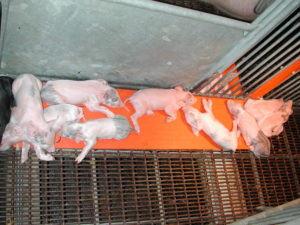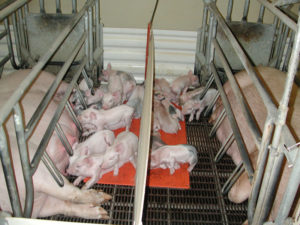As a pig farmer, you know that raising pigs from birth can be challenging. From offering proper nourishment to providing a safe, temperature-controlled environment, there are many requirements for maintaining the optimum health of a piglet. Scours, an illness that affects newborn piglets, is a common issue that many farmers have to deal with.
Scours, which is diarrhea in piglets, happens when the gastrointestinal system fails to perform properly, often between 12 and 96 hours after birth. According to NADIS Animal Health Skills, scours can occur when there is:
- A disruption to the functionality of the stomach
- Poor digestion or absorption in the small intestine
- Excess fluid outpouring as a result of contaminants
- An inability of the large intestine to absorb fluid
These failures in the gastrointestinal system are often caused by E. coli, parasites, prematurity, and damage to the gut. Thankfully, if you can catch it early enough, some instances of scours can be treated with an oral antibiotic and electrolytes.
Prevention Methods
To avoid getting to the point of needing antibiotics, it’s important to understand how to prevent or lower the chances of scours occurring in the first place.
An environment that isn’t conducive to the needs of piglets can play a major role in the development of scours. When sows and piglets are housed in the same environment, which they often are, providing the proper environmental requirements can be a challenge. This is because your piglets must have a warmer environment to conserve their body heat, unlike sows, who prefer cooler temperatures. In addition to keeping  tabs on ventilation, another way for you to maintain the proper heat and temperature for piglets is by adding heating pads to their creep area. If this area isn’t warm enough, the stress of the cool temperatures can lead to scours.
tabs on ventilation, another way for you to maintain the proper heat and temperature for piglets is by adding heating pads to their creep area. If this area isn’t warm enough, the stress of the cool temperatures can lead to scours.
In addition to heating pads providing proper temperatures, additional prevention methods include making sure the sow’s milk supply is sufficient, the transition from milk to solid feed is seamless and that a hygienic environment is thoroughly maintained.
Stanfield® Pig Heating Pad
Osborne’s Stanfield pig heating pads help pig farmers maintain safe and comfortable microclimates for their livestock. They also maximize energy efficiency, using as little as a third of the electricity of heat lamps. At full power, Stanfield pig heating mats for farrowing operate about 30-35° F (16-20° C) above room temperature, while those designed for nurseries and larger animals provide temperatures of 20-25° F (11-14° C) above room temperature. These heating pads also provide a warm area on which piglets can rest, keeping them away from nursing sows and helping to prevent losses from crushing. 
Composed of a tough fiberglass-reinforced composite, Stanfield pig heating pads are durable and easily cleaned. They help to block drafts from below and provide piglets with a solid surface on which to rest. The fire-retardant and water-resistant materials from which these pig heating pads are made create a safer environment in which piglets can grow. Through the use of automatic temperature controls, the heat they put out can also be decreased as pigs grow, lowering energy costs further.
To learn more about our heating pads for pigs and other livestock equipment, please contact us today.



